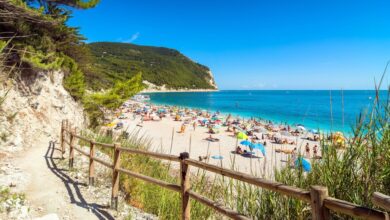Cruise to Nome: America’s first deep-water port for the Arctic to host military cruise ships

ANCHORAGE, Alaska (AP) — The cruise ship carrying about 1,000 passengers anchored at Nome, too big to squeeze into the tundra city’s small harbor. The well-to-do tourists had to saunter in small boats for another ride to the coast.
It was 2016, and at that time the cruise ship Serenity was the largest ship ever to pass through the Northwest Passage.
But as Arctic sea ice succumbs to the pressures of global warming and opens up shipping lanes around the world, more tourists are venturing to Nome — a northwestern Alaskan destination better known for the Iditarod Trail sled dog race and its gold rush in 1898 than luxury travel.
The problem remains: there is no place to park the big boats. While smaller cruise ships can dock, officials say of the 12 arriving this year, half will be anchoring offshore.
That is expected to change, as a more than $600 million expansion will make Nome, with a population of 3,500, the country’s first deep-sea Arctic port. The expansion, which is expected to be operational by the end of the decade, will accommodate not only larger cruise ships with up to 4,000 passengers, but also freighters to deliver additional goods to the region’s 60 Alaska Native villages, and to military ships because of the presence of Russian and Chinese ships in the Arctic.
It’s a prospect that thrills business owners and officials in Nome, but worries others concerned about the impact of additional tourists and shipping traffic on the environment and the animals on which Alaskans depend for their livelihoods.
The expansion will “support our local economy and the local artists here, the native artists who have access to the visitors and teach and share our culture and language and how we make our beautiful art,” said Alice Bioff, an Inupiaq resident of name.
Bioff was a guide who greeted the passengers of the Serenity when they arrived in 2016. One of the guests admired her cloth kuspuk, a traditional Alaskan native garment that resembles a smock, and wanted to know if it was water resistant.
It wasn’t, but the interaction inspired Bioff to create her own line of waterproof jackets in the style of kuspuks. She now sells to tourists and locals alike from her own Naataq Gear gift shop, a shop in the Post Office, where about 20 Native Alaskan artists offer ivory carvings, beadwork, or paintings on consignment.
Studies show that cruise ship passengers typically spend about $100 a day in Nome, city manager Glenn Steckman said.
With the expansion, he hopes guests on larger cruise ships will extend their stay to experience more of Nome and the tundra, view wild musk ox or grab a drink at the 123-year-old Board of Trade Saloon.
Climate change makes all this possible.
Founded after the discovery of gold in 1898, Nome has experienced six of the ten warmest winters this century. Bering Strait shipping lanes have only gotten busier since 2009, from 262 transits that year to 509 in 2022.
“We will be the first deep draft arctic port, but probably not the last,” said Nome Mayor John Handeland.
The Bering Sea ice reaches Nome on average in late November or December, about two or three weeks later than it did 50 years ago, said Rick Thoman, a climate specialist at the International Arctic Research Center at the University of Alaska Fairbanks.
In 2019, mushers in the Iditarod, who normally float their dog teams across the ice of the Bering Sea to the finish line in Nome, were forced onto the beach due to open water. The ice cream season will only get shorter, Thoman said.
The existing harbor road was completed in the mid-1980s. The expansion will be realized in three phases and will in fact double the size. The first part of the project is funded by $250 million in federal infrastructure money with an additional $175 million from the Alaska Legislature. Fieldwork is expected to begin next year.
Currently, three ships can dock at the same time; the extended dock can accommodate seven to ten.
Workers will dredge a new 40-foot deep basin that will allow large cruise ships, cargo ships and any U.S. military ship except aircraft carriers to dock, said port director Joy Baker.
US Representative Dan Sullivan, an Alaskan Republican, said the expanded port will become the centerpiece of US strategic infrastructure in the Arctic. The Army is building up resources in Alaska, placing fighter jets at bases in Anchorage and Fairbanks, creating a new airborne division in Alaska, train soldiers for future cold-weather conflicts and has missile defense capabilities.
“The way you have a presence in the Arctic is to have military assets and the infrastructure that supports those assets,” Sullivan said.
The northern seas near Alaska are getting busier. A US Coast Guard patrol board found seven Chinese and Russian naval ships participated in an exercise last year about 86 miles (138 kilometers) north of Alaska’s Kiska Island.
Coast Guard ships also encountered Chinese ships 50 miles off Alaska’s Aleutian Islands in 2021.
NATO Secretary General Jens Stoltenberg last year r warned that Russia and China have promised to cooperate in the Arctic, “a deepening strategic partnership that challenges our values and interests.”
Still, the prospect of Nome welcoming more tourists and a larger military presence disturbs some residents. Austin Ahmasuk, a resident of Inupiaq, said the port’s original construction displaced an area traditionally used for subsistence hunting or fishing, and the expansion will not help.
“The Port of Nome is development for development’s sake,” Ahmasuk said.




